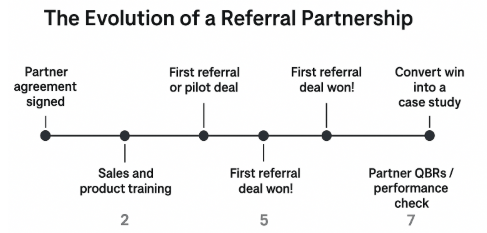
The Partnership Playbook
How to go from ZERO to ONE
Read Time = 3 minutes
Partnerships are a shortcut for business growth.
They give you instant access to someone else’s audience. A faster route to trust. A way to skip years of slow distribution building.
But when they go wrong?
They turn into endless coffee chats, vague promises, and “let’s circle back next quarter” conversations.
My old CEO used to say: “you gotta kiss a lot of frogs to find your princess.”
So here’s how to build partnerships that actually drive revenue.
Five rules to go from ZERO → ONE.

ZoomInfo brings your prospecting, insights, and engagement tools into one workspace — built for speed, accuracy, and execution.
1. Fit Beats Commission
If your main pitch is “we’ll pay you 20% rev share” you’ve already lost.
No one wakes up excited to sell your product. They wake up thinking about how to sell more of theirs.
Your job is to make your product the reason they win deals.
Does it fill a gap that keeps them from closing business?
Does it help them charge more for what they already do?
Does it make their customers stickier or happier?
The money is nice — but the real motivator is momentum.
Help them sell more of what they already believe in. The commission becomes gravy.
2. Borrow Distribution Before You Build It
When you’re breaking into a new market — whether it’s a region, vertical, or segment — partners are your fastest wedge.
Instead of flying reps halfway around the world or burning quarters testing messaging, borrow trust from someone who’s already there.
Use their credibility to get your first wins.
Once you’ve proven product-market fit and built predictable pipeline, then go direct.
Partners first. Then add headcount. That’s how smart companies derisk expansion.
3. Enablement > Agreements
A signed partner agreement isn’t an achievement, it’s the starting line.
Most partnerships die because no one follows through.
You don’t just send a PDF battle card and wait for referrals to start flowing.
Book the flight. Walk their reps through the story. Sit in on calls.
Treat their sales team like your own — Train them. Feed them content. Use shared slack channels. Align incentives to mutual goals (SPIFFs).
Paper partnerships don’t sell. People do.

4. Reciprocity Rules
Want a partner’s attention? Send them a deal. Make an introduction. Promote them to your audience.
It’s the fastest way to cut through the noise.
Most partnerships stall because both sides wait for the other to move first.
The best ones start when someone gives without expectation.
At my last company we started sending Netsuite business before they even knew who we were. Eventually, they noticed and we had 100s of reps selling our product
Some people refer to partnerships as “coin operated” — insert lead, expect return.
The best ones treat them like relationships: invest early, compound later.
(I even use this approach Twitter growth and my newsletter. I will recommend a bigger account or writer and send them followers/subscribers/customers. I want to prove value before reaching out)
5. Build for Optionality (a.k.a. the M&A Angle)
If you want a company to buy you someday, start by helping them win customers today.
Integrate deeply. Co-sell. Embed your product in their workflows until it’s hard to ignore you.
When the partnership drives real revenue, acquisition becomes a logical next step.
The Bottom Line:
Five truths worth remembering:
Fit beats commission
Borrow distribution before you build it
Enablement is everything
Give before you ask
Partnerships can become M&A
Every partnership starts with momentum — and momentum starts when you send business first.
Give. Give. Give. Get.
Until next Thursday,
TSG
P.S. I reply to all emails.
